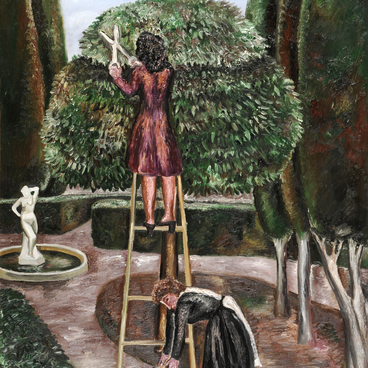After graduating from Moscow’s Surikov Institute in 1975, ‘having acquired a solid academic background, learning to observe and realistically convey what she saw, ” she finds her own unique style, cumulating and synthesizing the traditions and achievements in various artistic trends. The figurative and color excerpts in her works are always reconceived, transformed by the artist’s individual brushwork: the images are ambiguous and multivocal, the filigreed language of allegories and metaphors creates a special, ‘encoded’ world that does not open immediately, and not to everyone, but only to those who can ‘hack’ and understand this visual ‘access code’.
Family Portrait, like other works done by the artist in the 1970-1980s, is distinguished in terms of technique by classical ‘completeness’, from the undercoat to the glazing, which creates the illusion of reality. But this is not the reality of the earthly world, but of the world created by Olga Bulgakova. The images of the artist, her husband, the artist Aleksandr Sitnikov, and their daughter Natalia are recognizable, but not equal to themselves. The conditionality of the forms’ plasticity, the modeling of light and shadow, the locality of color, frozen and meaningful poses - comparable to medieval miniatures and icons - give the images a conceptual generalization and symbolism. The interlacing of unnaturally curved arms that creates a complex, repeating pattern of swastikas, the ancient solar amulet signs, further accentuates the theme of protection, which Bulgakova interprets not as an action in the face of a specific threat, but as a remarkable property, the essence of a family, a home, that is close to the concept of “care”. The parents shield the child’s hands, but the girl also tries to shield them with her small, heartwarming figure, with her arms outstretched to the sides and a bouquet of flowers raised up. They are all equal, and all are protected.
The family is the entire Universe, whose dual cornerstone is the red, feminine inception and the green, masculine one. These contrasting colors do not conflict with themselves in the picture, but complement each other and merge into a single whole. In addition to those, the artist uses two more colors: golden ocher when painting hands, faces, and hair, and white for the girl’s dress. But they are just an undercoat, shining through the red and green overtones that help create the shape, dimensions, and plasticity of the figures. This uncompromising coloristic restriction is designed to focus attention on the inner philosophical content of the picture.
Family Portrait, like other works done by the artist in the 1970-1980s, is distinguished in terms of technique by classical ‘completeness’, from the undercoat to the glazing, which creates the illusion of reality. But this is not the reality of the earthly world, but of the world created by Olga Bulgakova. The images of the artist, her husband, the artist Aleksandr Sitnikov, and their daughter Natalia are recognizable, but not equal to themselves. The conditionality of the forms’ plasticity, the modeling of light and shadow, the locality of color, frozen and meaningful poses - comparable to medieval miniatures and icons - give the images a conceptual generalization and symbolism. The interlacing of unnaturally curved arms that creates a complex, repeating pattern of swastikas, the ancient solar amulet signs, further accentuates the theme of protection, which Bulgakova interprets not as an action in the face of a specific threat, but as a remarkable property, the essence of a family, a home, that is close to the concept of “care”. The parents shield the child’s hands, but the girl also tries to shield them with her small, heartwarming figure, with her arms outstretched to the sides and a bouquet of flowers raised up. They are all equal, and all are protected.
The family is the entire Universe, whose dual cornerstone is the red, feminine inception and the green, masculine one. These contrasting colors do not conflict with themselves in the picture, but complement each other and merge into a single whole. In addition to those, the artist uses two more colors: golden ocher when painting hands, faces, and hair, and white for the girl’s dress. But they are just an undercoat, shining through the red and green overtones that help create the shape, dimensions, and plasticity of the figures. This uncompromising coloristic restriction is designed to focus attention on the inner philosophical content of the picture.




